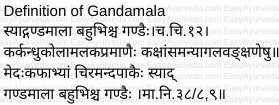Gandamala – Meaning, Symptoms, Treatment
By Dr Raghuram Y.S. MD (Ay) & Dr Manasa, B.A.M.S
Gandamala is a pathological condition which presents as swelling in the neck. While Galaganda is a single swelling occurring on the side of the neck, gandamala is a series of similar swellings in the neck which looks like a garland of swellings.
Table of Contents
Meaning of Gandamala
Ganda means a swelling having the shape of button, boil, pimple, cheekbone, bubble or bladder. Mala means garland.
Garland of swellings around the neck is called Gandamala.
While Master Charaka has confined these swellings to the neck, Madhava Nidana treatise mentions other regions too where swelling is manifested.
Read – Charaka – Shotha Chikitsa 12th Chapter
Definition, Pathogenesis
As already mentioned, according to Charaka, Gandamala is formed by multiple swellings around the sides of the neck.
Aggravated kapha and meda (fat) cause many swellings which suppurate slowly and gradually in the axilla (arm pit), scapular region, and nape of the neck, neck and groins. These swellings are of the shape of small jujube fruit, big jujube fruit or gooseberry. This pathological condition is called as Gandamala.
Though kapha and meda are mainly involved in the causation of the disease the other doshas i.e. vata and pitta too get associated with the disease.
According to Bhoja, Gandamala is a type of Apachi, another swelling disorder. In Gandamala there are multiple swellings around the neck, heart region and joints of the jaw.
Read – Shotha: Causes, Types, Treatment, Medicines
Sanskrit Verses

Treatment
The treatment principles for Gandamala are same as those of Galaganda. These principles can be adopted in the treatment of this disease as and when needed skillfully and according to the situation of the disease and diseased.
- Siravedha – venesection
- Purgation
- Nasal instillation
- Medicated smoking
- Oral consumption of ghee
Internal Medication
Kanchanara Kwatha
Decoction of Kanchanara bark – Bauhinia variegata consumed with Ginger powder
Alternatively 48 grams or 24 grams Kanchanara root ground with rice water and consumed.
Varuna Kwatha
Decoction Varuna roots – Crataeva nurvula consumed with honey.
Aindri – Girikarnika Prayoga
Aindri roots– Bacopa monnieri or Girikarnika – Clitoria ternatea ground with cow’s urine and consumed.
Alambusha Prayoga
Juice of tender leaves of Alambusha – Sphaeranthus indicus should be consumed.
Medicines for Gandamala from Sahasra yoga text book
Panchatiktaka guggulu Ghrita
Brihat Madhusnuhi Rasayana
External Medication
Chakramarda Taila
Mustard oil cooked with 48 grams of Chakramarda root paste and Bhringaraja juice – Eclipta alba on mild fire. When contents are processed properly ¼ quantity of Sindura – vermilion should be added. Application of this Chakramarda Taila will cure Gandamala.
Gunja Taila
Oil is prepared with roots and fruits paste of Gunja – Abrus precatorius and water – twice the quantity of the paste. This oil is used for massage and as nasal drops in Gandamala.
Sarshapadi Lepa
Paste prepared from the below mentioned ingredients made in sour buttermilk should be applied on gandamala –
- Mustard– Brassica nigra
- Shigru bija – seeds of Moringa oleifera
- Shana bija – Crotalaria verrucosa
- Atasi bija – Linum usitatissimum
- Barley – Hordeum vulgare
- Mulaka bija – seeds of Raphanus sativus
Aragvadha Prayoga
Aragvadha root bark – Cassia fistula ground with rice water and paste is prepared.
Chuchundari Taila
Oil processed with Chuchundari meat – a type of mouse is used for massaging Gandamala swellings.
Nasal medication
Below mentioned medicaments used for nasal drops –
- Nirgundi roots – Vitex negundo rubbed with water
- Koshataki juice– Luffa acutangula mixed with Pippali powder – Piper longum
- Tumbi juice– Lagenaria siceraria mixed with Pippali powder
- Oil prepared from Neem
- Powder of Vacha – Acorus calamus and Pippali mixed in honey
- Aragvadha root bark– Cassia fistula ground with rice water.
- Oil prepared from Shakotaka – Streblus asper
- Oil prepared from Bimbi – Coccinia indica
- Oil prepared from Ashvamara – Nerium indicum
- Oil prepared from Nirgundi – Vitex negundo
Pathya – apathya according to Yogaratnakara
Wholesome herbs, diet and habits
Old ghee, old red rice,barley, green gram, pointed gourd, red variety of drumstick, bitter gourd, dry, pungent and carminative substances, guggul, asphaltum etc.
Unwholesome herbs, diet and habits
Milk and milk products, sugarcane juice and its products, meat of animals of marshy lands, food items prepared from flour, sour, sweet, heavy to digest foods and foods that cause obstruction in the channel of circulation etc.
Click to Consult Dr Raghuram Y.S. MD (Ayu) – Skype









